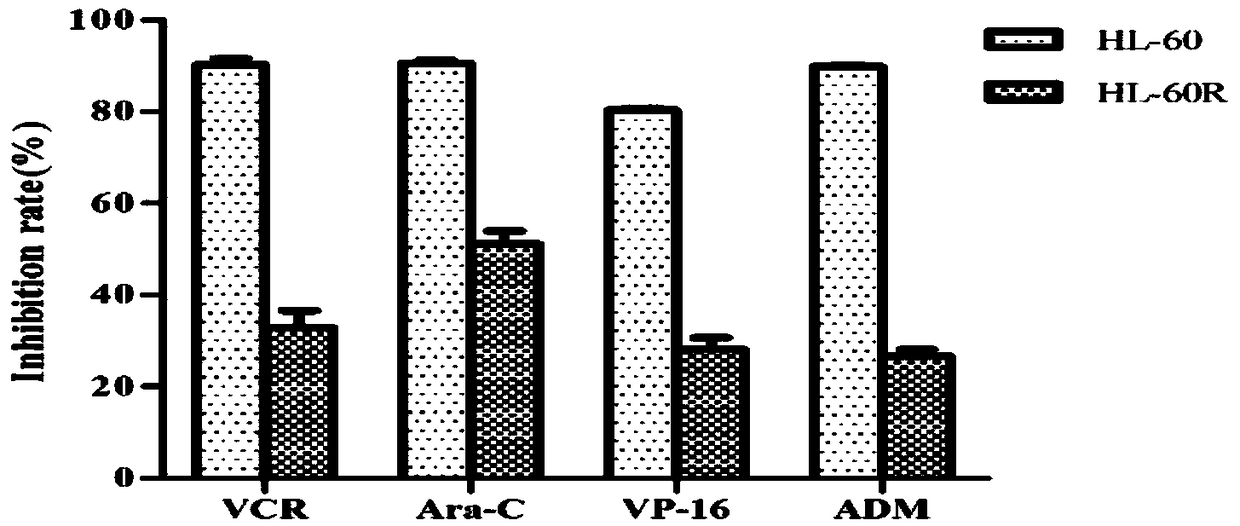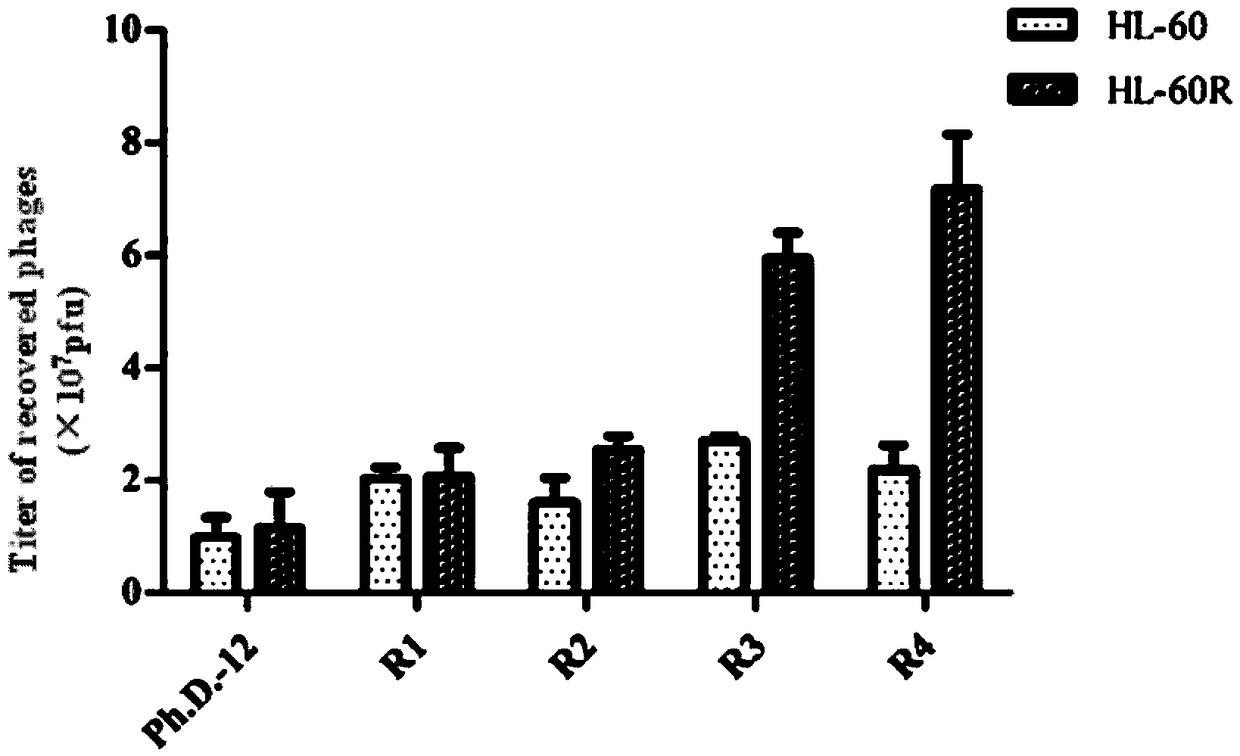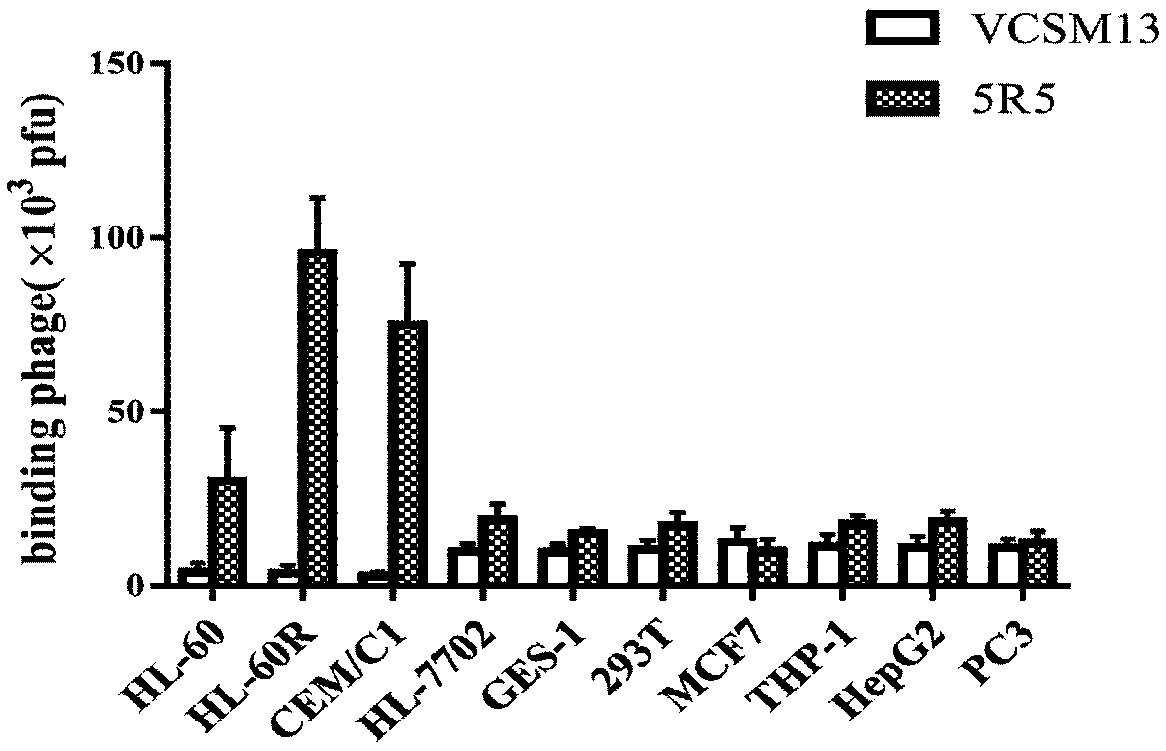Polypeptide specifically binding to ATRA-resistant acute myeloid leukemia cells and preparation method and application thereof
A specific, cellular technology, applied in the field of biomedicine, can solve the problems of low washing efficiency, poor repeatability of screening results, and inability to completely remove non-specifically bound phages, and achieve the effects of increased probability, sufficient contact and sufficient binding.
- Summary
- Abstract
- Description
- Claims
- Application Information
AI Technical Summary
Problems solved by technology
Method used
Image
Examples
Embodiment 1
[0065] Construction and identification of all-trans retinoic acid (ATRA) drug-resistant strains of acute myeloid leukemia cells
[0066] In this example, the following methods and steps are used to construct and identify all-trans retinoic acid-resistant strains of acute promyelocytic leukemia cells
[0067] 1. Concentration-increasing intermittent induction method to induce ATRA drug-resistant cell lines
[0068] 1. Take HL-60 cells in the logarithmic growth phase and adjust the cell concentration to 1×10 4 individual / mL.
[0069] 2. Add ATRA to the 1640 culture medium to make the final concentration 10 -9 mol / L, after culturing for 48 hours, the ATRA-containing medium was discarded, and the cells were cultured with RPMI-1640 medium for 2 to 3 generations.
[0070] 3. Culture the cells for 48 hours in 1640 culture medium containing ATRA, in which the concentration of ATRA is doubled, that is, 2×10 -9 mol / L.
[0071] 4. Repeated medium change and subculture, gradually inc...
Embodiment 2
[0088] Screening and preparation of phage-peptide (pepNo.5R5)
[0089] In this example, pepNo.5R5 was screened and prepared by the following methods and steps.
[0090] 1. Preliminary screening of phage clones that bind to ATRA-resistant AML cell lines
[0091] Using microfluidics-based phage display peptide library screening technology, multiple rounds of whole-cell subtractive screening were carried out to preliminarily screen out phage clones that specifically bind to the ATRA-resistant AML cell line HL-60R. The specific steps are as follows:
[0092] 1. Determination of phage titer
[0093] (1) Inoculate a single colony in LB-Tet medium and culture on a shaker at 37°C until mid-logarithmic growth (OD600≈0.5).
[0094] (2) When the bacteria grow, melt the high-layer agar in a water bath, and use one tube for each phage dilution. Store at 55°C for later use.
[0095] (3) Pre-warm the LB / IPTG / X-gal plate at 37°C, and prepare one plate for each phage dilution.
[0096](4)...
Embodiment 3
[0142] Binding specificity of pepNo.5R5 to drug-resistant cells
[0143] 1. Identify the binding of phage clones to various cell lines by titer assay
[0144] In this experiment, a phage clone carrying a pepNo.5R5 fragment was selected, and the binding ability of the phage clone to different cell lines was identified by a titer method, and the method was the same as in Example 2.
[0145] Experimental results such as image 3 As shown, the binding ability of pepNo.5R5 to the drug-resistant cell HL-60R was significantly stronger than that of the corresponding parental cell; with other normal cell lines (HL-7702, GES-1, 293T) and tumor cell lines (MCF-7, THP -1, HepG2, PC3) had very weak binding abilities. In addition, the 5R5 phage-displayed polypeptide can also bind to the multidrug-resistant strain CEM / C1 of acute lymphoblastic leukemia cells, indicating that this sequence may be a broad-spectrum binding peptide for drug-resistant cells.
[0146] 2. Immunofluorescence meth...
PUM
 Login to View More
Login to View More Abstract
Description
Claims
Application Information
 Login to View More
Login to View More - R&D
- Intellectual Property
- Life Sciences
- Materials
- Tech Scout
- Unparalleled Data Quality
- Higher Quality Content
- 60% Fewer Hallucinations
Browse by: Latest US Patents, China's latest patents, Technical Efficacy Thesaurus, Application Domain, Technology Topic, Popular Technical Reports.
© 2025 PatSnap. All rights reserved.Legal|Privacy policy|Modern Slavery Act Transparency Statement|Sitemap|About US| Contact US: help@patsnap.com



